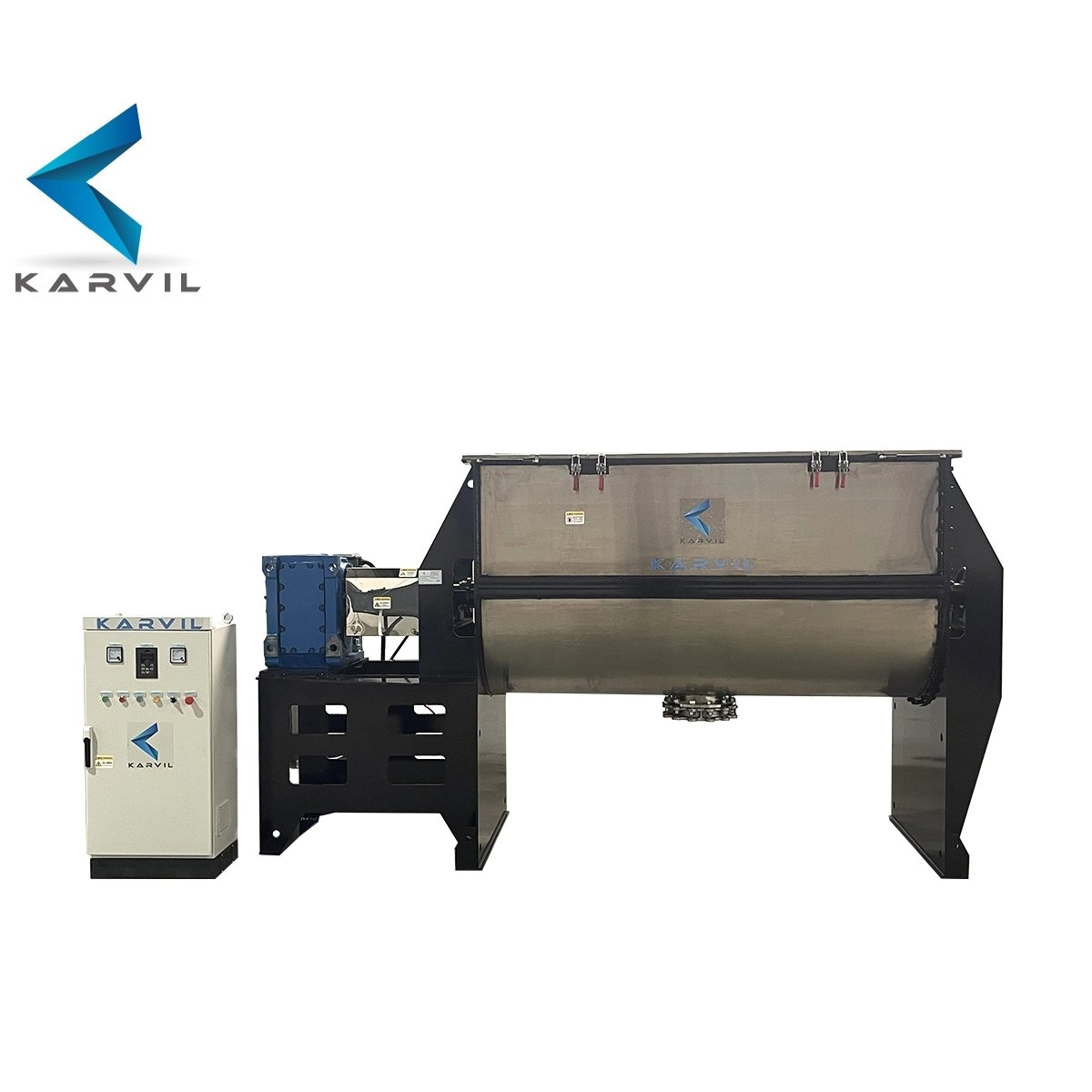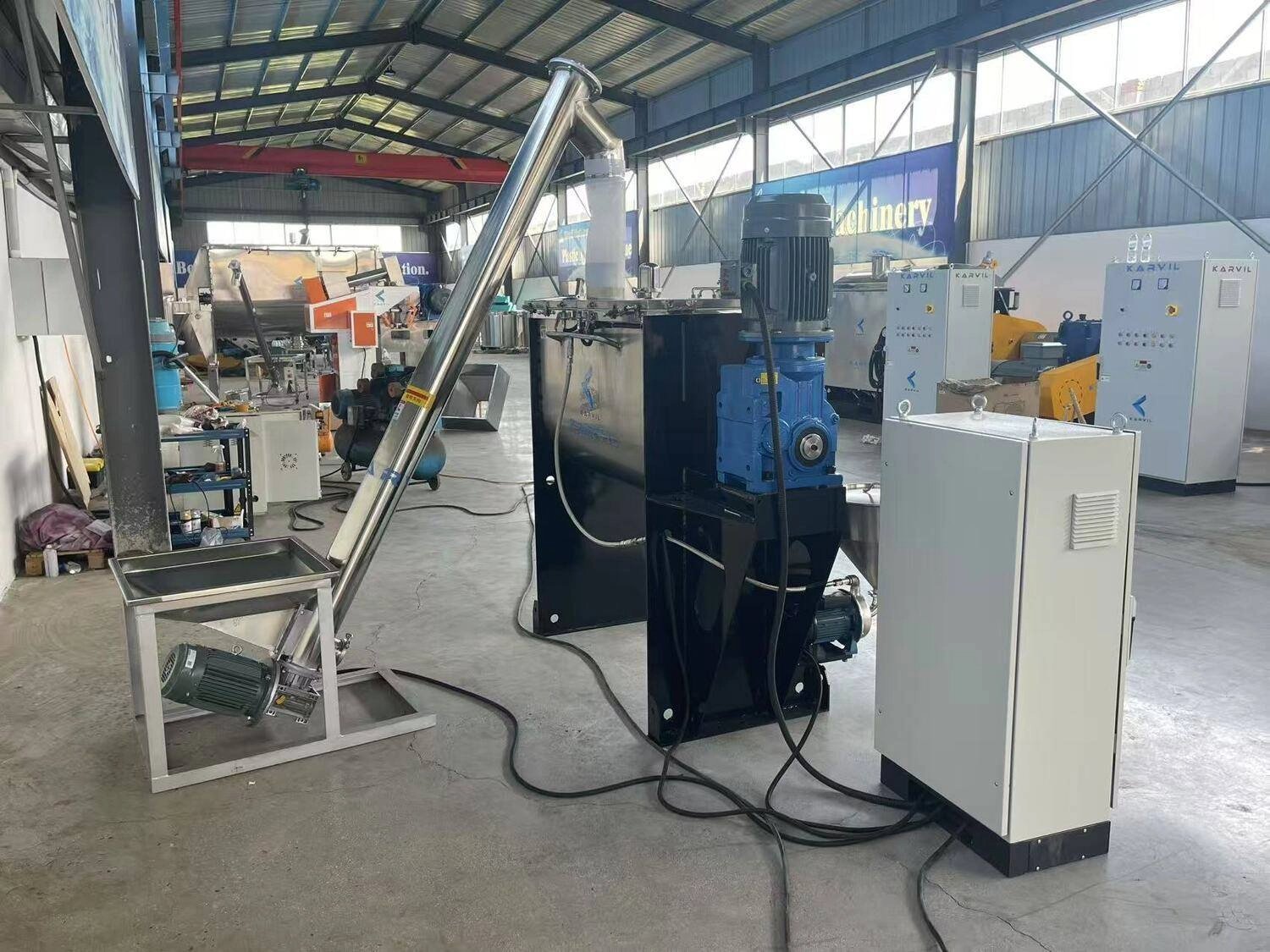Views: 11 Author: Site Editor Publish Time: 2025-10-23 Origin: Site

Definition and Basic Functionality
A ribbon blender is a kind of factory mixer. It mixes dry powders, small grains, or soft pastes in an even way. These blenders have a shell shaped like a U. Inside it, there is a turning agitator. This agitator has two helical ribbons that spin. They turn in a flat trough. The ribbons push materials in different directions. This leads to a quick and even mixing job.
Ribbon mixers are common in factories that handle large amounts of dry solids. They mix them well. Their simple build, strong make, and easy changes make them key tools. You find them in areas like making food, drugs, and chemicals. People like them because they work well for many tasks. They help get the job done without much trouble. Over time, these machines have become a go-to choice for many workers.
The main part of a ribbon blender is the U-shaped trough. It holds the materials. This shape keeps everything in a tight space. There, the mixing happens well. The design also makes cleaning simple. Maintenance is not hard either. Workers can reach inside easily. This saves time during busy shifts. The trough's curve helps materials move smoothly. It stops buildup in corners. That is why it works so well for daily use.
The agitator looks like two helical ribbons. One is inside, and one is outside. They create a flow of materials in two ways. This helps mix powders and solid bits fast. From the sides, the outer ribbons pull stuff toward the middle. The inner ones push it back to the edges. This back-and-forth action spreads things out quick. It cuts down on spots where nothing mixes. No dead areas mean better results every time. The ribbons are close to the walls. That adds a bit of rub to break up clumps. Overall, it makes the whole batch even.
A center shaft links to a motor drive. It makes the ribbons turn. The drive can use belts or gears straight from the motor. This cuts down on fixes needed. Speed comes from variable frequency drives, or VFDs. They let you set the turn rate just right. This controls how hard the mix gets. For light jobs, go slow. For tougher ones, speed up a bit. The system runs smooth. It handles different loads without issues. Safety features stop overloads too.
At the bottom or side, there is a valve to let out the mix. It empties fast. Some use butterfly or plug types. They stop bits from sticking during pour. This keeps the flow clean. No mess means less waste. Workers open it quick after the cycle ends. Then, the next batch starts sooner.
Ribbon blenders work on convection and shear. Convection moves big groups of material around. Shear rubs particles against each other. The ribbons turn and lift stuff from end to end. They also push it side to side. This rubs materials on walls and each other. It spreads them out even. The gap between ribbon and trough is small. That adds the shear part. Together, they make a full mix. No part gets left out. It's gentle but strong enough for most jobs.
In a flat setup, materials go round and round in the trough. Both ribbon sets help with this. The blender has a U-shaped flat trough. The agitator has inner and outer helical ribbons. They move material the opposite way. This setup mixes fast with little power. The outer ribbon scoops from the sides. It brings to center. Inner one takes from middle to walls. This loop keeps going. It covers the whole space. Energy use stays low. That's good for bills. The process is steady. Batches come out the same each time.
These blenders turn slow, from 20 to 65 turns per minute. They reach even mix in 5 to 15 minutes. It depends on how much you have and what it's like. But axial mix is not great. That means up-and-down flow is weak. So, fill it in layers. Put even parts of each item before start. This helps spread from the get-go. Once running, watch the time. Small batches mix faster. Big ones take longer. Test a sample to check. If not even, run a bit more. Most times, it's ready quick.
Ribbon blenders fit best for dry powders that flow easy. Think flour, cake mixes, cement add-ins, drug powders, or plastic bits. The soft action keeps particles whole. It gives steady results. No breakage means better quality. In food, it blends spices even. In drugs, it keeps doses right. That's key for safety.
They do well with grains like sugar bits or salt. The low rub design handles them fine. But sticky powders can clump. They might block if not watched. Add a bit of flow aid if needed. Or check the load size. Most granules mix smooth. Crystals stay sharp. No fines from crush.
Main use is dry, but some handle soft pastes. Add liquid spray setups for that. They let in binders or tastes without soak. No lumps form. Keep it light though. Thick stuff needs other tools. For semi-solids, test first. See if it flows right.
If you need good powder gear, Karvil Machinery is a top pick. They make factory mixers for your setup. With long years in engineering, they know the field. Karvil serves food, chemical, drug, and farm areas. They give strong help and custom work. It's all about your needs.
Karvil's Ribbon Blender Mixer uses two helical ribbons. Contact parts are stainless steel SS304. This fights rust. Even with things like plant food or glues, it holds up.

The 500L Horizontal Ribbon Blender model has speed change from inverter, up to 46 turns per minute. It uses PTFE seals on shaft to stop leaks. Safety grids keep hands out. Dust collectors clean air. Liquid spray nozzles come with 1.5 kW pumps. Manual butterfly valves for out. Screw conveyors lift mix up to 2 meters. This links to next steps easy. The Karvil Machinery 500L horizontal ribbon blender works for exact mix of heat-proof materials. It handles tough jobs well.
The two ribbons mix full for heat-proof powders and adds. Each batch hits standards. No over mix or wear.
Made from stainless and carbon steel mix. It lasts in tough spots. Key touch parts in SS304 for chemicals.
Pick sizes from 100 to 10,000 L. Power from 1.5 to 75 kW. Outlets center or side. Spray systems, hoppers with tops. All fit your work. Total volume(L) - 100 to 10000
Inside is smooth to cut residue. Mirror polish option for clean spots like food or drugs. Internal surface finish is crucial for cleaning and avoiding cross-contamination
Great for drink powders, spice mixes, bake starts. It keeps steady without hurt to bits like sugar or dry veggies. Taste stays true. Colors even out.
Big in pill makes. Active parts spread even in fillers. No change to bit sizes. Safe and right dose.
For color spread or start-up mixes. Handles eat-away stuff. Liquid add helps too. Key in chem lines.
Fits farm feed, plant seeds. Screw lift sends to pack or press fast. Cycle ends clean.
Pick for your daily flow. WLDH-500 does 500 L per go. Mixed amount/batch (L) - 150-300
Easy flow powders best. Sticky ones might need paddle changes. Ribbon blenders may be less effective with cohesive powders
Inverter motors give flex for recipes. Good for change in weight. Main Shaft Speed: 46 r/min (Variable)
Get grids, dust pulls, tight tops, locks, hoods. For rules like GMP or HACCP.
Karvil has years in making with new tools. Not just gear, but full plans for your flow. Factory direct cuts cost. Still top work. Talk before buy. Help after set up. Our fully equipped modern laboratory/technical center is at your disposal.
For tips on next mixer or order, call WhatsApp +8619905425406 or mail. Ask for brochures on site under Horizontal Ribbon Blender.
Q: Can I mix wet materials using a ribbon blender?
A: Yes—but only light pastes or semi-solid products when equipped with liquid spray systems; heavy viscous mixtures are better handled by other mixer types.
Q: How long does it take to clean between batches?
A: With smooth internal finishes like SS304 stainless steel surfaces—and optional mirror polishing—cleaning typically takes less than an hour depending on residue type.
Q: Is it safe to operate under full load?
A: Yes—especially when using models equipped with VFDs that allow smoother startup under full load conditions while minimizing mechanical stress during operation.
Discover why sigma blade mixers are essential for high-viscosity adhesives and sealants. Karvil offers lab & industrial sigma kneader mixers with vacuum, heating, and high-shear performance.
Compare double planetary mixer vs single planetary mixer for high-viscosity materials up to 10 million cps. Discover why double planetary mixers excel in battery slurry, adhesives, sealants with superior kneading, vacuum deaeration and homogeneity.
We are thrilled to announce the shipment of our heavy-duty 5000L Horizontal Ribbon Mixer to our valued client in New Zealand.Designed for high-efficiency industrial mixing, this unit is customized to handle specific powder materials including Mineral Salts, Lime Powder, and Magnesium Oxide.⚙️ Key Fe
Discover the key advantages of ribbon blenders for powder mixing: uniform blending, versatility across industries, high efficiency, gentle action, and easy maintenance. Explore Karvil Machinery's durable solutions.
Discover if sigma blade mixers are ideal for wet granulation in pharmaceuticals and chemicals. Explore advantages, Karvil's Z blade mixers features, design benefits, and comparisons for efficient mixing.
If you are working with Polyester BMC (Bulk Moulding Compound) or DMC, you know the struggle. The material is heavy, incredibly sticky, and tricky to mix.The biggest headache? Glass fibres.You need strong shear force to mix the resin and filler paste, but if the blades run too fast or too hard once
We have successfully completed the fabrication and testing of 10 Sigma Blade Mixers tailored for a specialized application in Turkey involving Cotton and Alcohol/Solvents.Project Breakdown & Technical Focus:Processing cotton with solvents requires high shear force combined with rigorous safety stand
Discover the core construction of Sigma blade mixers: Z-shaped stainless steel blades, jacketed U-troughs for precise temperature control, and hydraulic discharge systems. Ideal for high-viscosity mixing in rocket fuel, explosives, and more. Explore innovations from Karvil for efficient, safe blending.